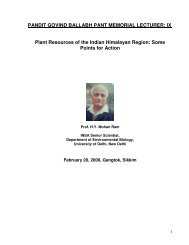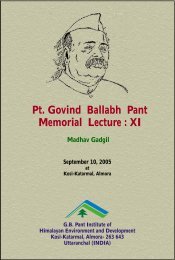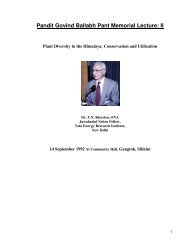PANDIT GOVIND BALLABH PANT MEMORIAL LECTURE: VII ...
PANDIT GOVIND BALLABH PANT MEMORIAL LECTURE: VII ...
PANDIT GOVIND BALLABH PANT MEMORIAL LECTURE: VII ...
You also want an ePaper? Increase the reach of your titles
YUMPU automatically turns print PDFs into web optimized ePapers that Google loves.
Figure. 1. Marginalized woman in the Himalaya, whose life has been affected by<br />
mountain hazards and the deplorable state of the natural environment. Yet she occupies a<br />
pivotal position in the socioeconomic scheme of things.<br />
Figure 2. Crustal plate that makes the Indian subcontinent is sliding under the<br />
Himalaya at the rate of 18 7 mm per year, along what is known as the Main Boundary<br />
Thrust (MBT). The fast-rising Great Himalaya domain is moving up the Main Central<br />
Htrust (MCT) that separates the populated Lesser Himalaya terrane from the snowy<br />
Great Himalaya domain. The Siwalik in the southern front is separated from the Indo-<br />
Gangetic Plains by the Himalayan Frontal Fault (HFF). All these faults are quite active,<br />
that is, the mountain blocks are still moving up and down and sideways on them. As the<br />
blocks move suddenly, the ground shakes perceptibly. Black circles indicate the<br />
epicentres of such seismic events.<br />
(Block diagram after Jackson and Bilham (1994) and the epicentral map from Valdiya,<br />
1997)<br />
1. Quickened Earth Processes and Safety from Natural Hazards<br />
Geodynamically Active Domain<br />
Riven with multiplicity of faults that are quite active and shaken by earthquakes,<br />
which are far too frequent in several pockets, the geodynamically, sensitive, youthful<br />
Himalaya is going through unrelenting tectonic ferment. The crustal plate that makes<br />
the Indian subcontinent is sliding under the Himalayan mass (Figure2) at the rate of<br />
18±7 mm per year (Molnar, 1990). It is the titanic force of compression resulting from<br />
collision of India with mainland Asia (Figure 2) that is responsible for this tectonic turmoil<br />
of the mountain (Valdiya, 1988). Consequently, the mountain front is rising and<br />
frequently shaking.<br />
There are four 200 to 450 km long segments of the mountain arc which were<br />
ruptured in the last about one hundred years by earthquakes of magnitude more than 8<br />
– the northern Meghalaya (1897), the Kangra sector in western Himachal (1905), the<br />
south-central belt of Nepal (1934), and the northeastern Arunachal (1950). The three<br />
unruptured and presently seismically less active parts called “seismic gaps” (Figure 3)<br />
seem to be the sites of major earthquakes in the future (Gaur, 1993). For, it is in these<br />
segments of the mountain front where the strain is building up progressively, as the<br />
Indian plate pushes inexorably northward at the rate of 55 mm/yr. In the central<br />
segment that embraces western Nepal, Uttarakhand and western Himachal, no great<br />
earthquake has occurred since the 1255 A.D. event near Katmandu. The 1833 A.D.<br />
earthquake of magnitude 7.5 to 7.9 happened close to the rupture of 1934 earthquake<br />
of magnitude 8.1(Bilham, 1995). Practically the same seismotectonic situation obtains<br />
in the Garhwal sector (Chander and Gahalaut, 1995). Thus the seismic gaps remain<br />
5











